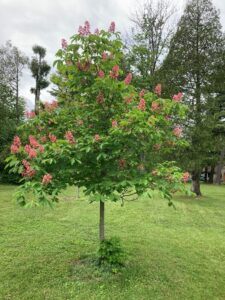
A Fort McNair Horse Chestnut. The tree is one of 31 trees identified as underused or uncommon in Iverson Park. Credit: Stevens Point Forestry Department
The Stevens Point Forestry Department has created an interactive GIS map called Iverson Park Trees. This map allows a self-guided tree walk that identifies 31 trees that are underused or not common in the area to help residents learn about uncommon trees they can incorporate in to their private property.
The interactive map focuses on Iverson Park’s value as a tree evaluation site. The Stevens Point Forestry Department test plants specific tree species here for a few years to see how well they do before the department decides to buy large quantities of the species and place them throughout the city.
Iverson Park is ideal for this project due to its variety of environments, with mixes of wet and dry soil patches, some parts sandy and windy and other areas not. Since past storms took out quite a few trees in the area, the Forestry Department decided to make the best of an unfortunate situation and use it as a testing site for tree species the city doesn’t typically plant.
Todd Ernster, Forestry & Landscape Operations Superintendent for the City of Stevens Point, said it is crucial to plant diverse tree species. “We are trying to diversify as much on public land as we can, but we would like to see more diversification on private land. We would also like to show off some of the neat plants that are out there.”
At this point, you might be wondering why is it important to have diversity at all?
Unfortunately, Wisconsin has seen its share of diseases and pests that has killed off tree species en masse: Dutch elm disease, oak wilt, and most widely known, the emerald ash borer. Diseases and pests such as these tend to focus on one tree genera and can devastate to the local population. Popular trees like maples can also make up a significant portion of the tree species, especially within urban settings. Todd warns that “if another insect or disease comes through that affects maple trees, it could wipe out another 25-50% of our trees, which would be very noticeable [for the local area]. Having [a more diverse proportion of tree species] is better for the environment overall,” Ernster said.
However, another issue is that these uncommon and underrepresented trees can be harder to find. Mr. Ernster discusses that “everyone is familiar with common trees like maples because 99% of the time that’s what our garden centers and home improvement stores have.” He continues that you often have to ask specifically if you want an uncommon species, which is difficult if you don’t know what you’re looking for. The Iverson Park Tree Walk map includes tree names and their exact location so you can visit them in person to become familiar with the species and if it might do well on your own property.
Are you worried that different tree species might not have the beautiful fall colors or other characteristics you’re looking for? Mr. Ernster relays that “diverse trees of a different kind can have the same aesthetics that we know and love.”
Todd Ernster says they plan to continue developing the interactive Iverson Park Tree Map to make it more informative to the average park go-er and tree enthusiast, including pictures of the trees throughout the different seasons. Currently, the app is accessible to anyone online, so you can visit the park and see the trees in person. You can find the map can be found at www.StevensPoint.com/treewalk. For any questions regarding the tree walk, please get in touch with the Stevens Point Forestry Department by phone at 715-346-1532 or email at ternseter@stevenspoint.com.
Todd Ernster remarked that developing the Iverson Park Tree Walk was a true team effort. The Stevens Point Forestry Department staff involved has put many hours of work into taking care in selecting the trees and ensuring their health as they grow. The interactive GIS map was made possible through funding from an Urban Forestry Grant from the WI DNR and with help from the Engineering Department.
